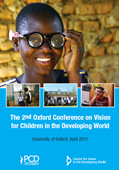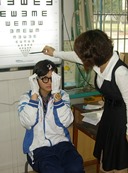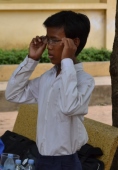It is estimated that globally there are around 815 million school-aged children who require some form of vision correction to see clearly. In developing countries alone the estimates are of 180 million children who could benefit from vision correction. The majority of these children do not have access to affordable eye examination or a pair of glasses.
Simply put, in resource poor countries there are not enough eye care professionals and the equipment and glasses used are often too expensive and difficult to obtain.
Impact of poor vision on child development
This massive number of children with poor vision presents a major issue for child development. Children with poor eye sight are more likely to suffer from poor academic performance, school absenteeism and dropout rates are higher and long term career prospects are poorer. Uncorrected vision in children will reduce the benefits of global investments in education and hinder the attainment of the education related
Millennium Development Goals (MDGs) and
Education for All (EFA).
Specialist in a School Health and Nutrition, Professor Don Bundy, from the World Bank agrees, “In many schools in low income countries, particularly in Africa, it is the exception to find a child with glasses. This does not reflect lack of need, but lack of access. Yet providing glasses to help children see would seem to be one of the most basic interventions necessary for children to take full advantage of education and grow up to lead productive lives."
 Vision conference
Vision conference
The 2nd Oxford Conference on Vision for Children in the Developing World held at Oxford University in April 2011 offered the opportunity to discuss the strategy for improving vision amongst school-age children in the developing world and was attended by development specialists, academics, vision experts, non-governmental organisations and representatives of the private sector.
The 2nd conference built on the conclusions of the 1st conference held in 2007 which identified new innovative technologies such as self-refraction with adjustable spectacles for use to improve adult vision in resource-poor settings.
 Child Vision in China
Child Vision in China
From 2008 - 2010 Partnership for Child Development, funded the three year Child Self Refraction Study (CSRS) to conduct three studies of self-refraction with adjustable spectacles among teenagers in Boston (USA) and in urban and rural China. The results of these studies, presented at the 2011 Conference, indicated that the overwhelming majority of children in the study settings could obtain excellent vision and good accuracy with self-refraction. The experts at the meeting concluded that the implementation of currently available spectacle technologies, as well as the provision of supporting personnel, needed to be scaled up to address uncorrected vision in children. Innovative new solutions such, such as ‘self-refraction’ with adjustable spectacles, had the potential to dramatically increase the coverage of programmes in resource-poor settings.
 Improving Child Vision in Cambodia
Improving Child Vision in Cambodia
PCD in partnership with the International Agency for the Prevention of Blindness (IAPB) brought together the Global Partnership for Education (GPE), the World Bank and Sightsavers carried out an operational study in Cambodia from May - June 2011 to explore how ready-made spectacles (or self-adjustable specs) can be provided as part of existing health screening and referral programmes.
For further information read the news article Improving Child Vision Through Schools in Cambodia
Key Resources
Useful Web Links

Watch Professor Josh Silver from the
Centre for Vision in the Developing World
give a TED lecture on the need for low
cost self-adjustable glasses.

